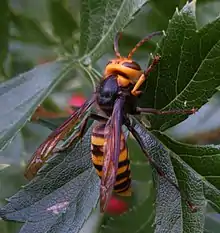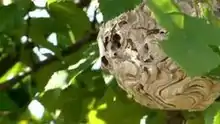Vespa analis
Vespa analis, the yellow-vented hornet, is a species of common hornet found in Southeast Asia.[1][2][3]
| Yellow-vented hornet | |
|---|---|
 | |
| Scientific classification | |
| Domain: | Eukaryota |
| Kingdom: | Animalia |
| Phylum: | Arthropoda |
| Class: | Insecta |
| Order: | Hymenoptera |
| Family: | Vespidae |
| Genus: | Vespa |
| Species: | V. analis |
| Binomial name | |
| Vespa analis Fabricius, 1775 | |
| Synonyms | |
| |
Taxonomy
This species has no recognised subspecies, and at least two described species are considered synonymous with it.[4]
Description
This species varies in colours and patterns, in Southeast Asia, they are usually black with a yellow marking on the tip of the abdomen (the sixth segment) In Singapore, they are coloured slightly lighter, with red or brown heads and pronotums.[5] Specimens from sub-tropical, mountainous or temperate areas have yellow heads. In areas where they occur with the Asian giant hornet, they tend to resemble it in colour and pattern.[5]
Distribution
This species is one of the most widely distributed hornets. It can be found in temperate areas such as Japan, Russia and Korea, and is also found over much of China and Taiwan, down to tropical regions like Singapore and Indonesia.[5]
Behaviours
Vespa analis is a typical tree-dwelling hornet.[5] Its nests are generally built from six to ten feet above ground, lower than those of Vespa affinis and Vespa velutina.[5] The nest envelope is usually quite dark and sturdy, and has a coarsely imbricate pattern, with large, obvious overlapping circular sections. In temperate areas, the nest gets only very slightly oval, and the colony size is generally not very large. However, nests in the tropics reach substantial sizes. There is also the same variation seen in nests of Vespa affinis; nests in tropical regions are tapered from the top and get wider further down.[5] Their diet is relatively similar to other hornet species of Southeast Asia, catching butterflies, honeybees and dragonflies. However, unlike some hornet species in Southeast Asia, they do not scavenge on dead animals or food left behind by people.[5]

This species is generally considered to be one of the least defensive species. However, in Japan, it is responsible for quite a number of attacks, due to its abundance and its fondness for building near human habitation.[5]
Life cycle
This species appears to have a fairly long colony cycle, as workers have been spotted trying to hunt in early January, indicating that some nests still have brood or new queens then.[5]
References
- "Vespa analis Fabricius, 1798". www.gbif.org. GBIF. Retrieved 2020-10-12.
- "Vespa analis (Yellow-vented hornet)". www.uniprot.org. UniProt. Retrieved 2020-10-12.
- Yoon, Kyungjae Andrew; Kim, Kyungmun; Nguyen, Phuong; Seo, Jong Bok; Park, Young Han; Kim, Ki-Gyoung; Seo, Hong-yul; Koh, Young Ho; Lee, Si Hyeock (2015-12-01). "Comparative functional venomics of social hornets Vespa crabro and Vespa analis". Journal of Asia-Pacific Entomology. 18 (4): 815–823. doi:10.1016/j.aspen.2015.10.005. Retrieved 2020-10-12.
- Carpenter, James M.; Dvořák, Libor; Kojima, Jun-Ichi; Nguyen, Lien T.P.; Perrard, Adrien; Pickett, Kurt M. (April 2011). "Taxonomic Notes on the Vespinae of Yunnan (Hymenoptera: Vespidae)". American Museum Novitates (3709): 1–10. doi:10.1206/3709.2. S2CID 85626082.
- "Vespa analis" at http://www.vespa-bicolor.net/main/vespid/vespa-analis.htm accessed on the 11th October 2020.
Sources
"Vespa analis" at http://www.vespa-bicolor.net/main/vespid/vespa-analis.htm accessed on the 11th October 2020